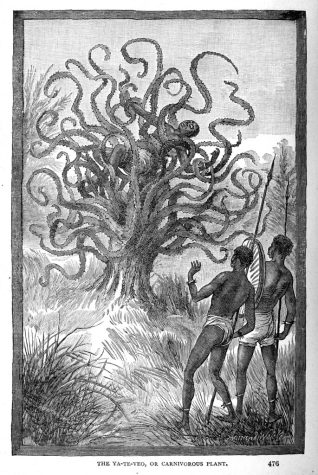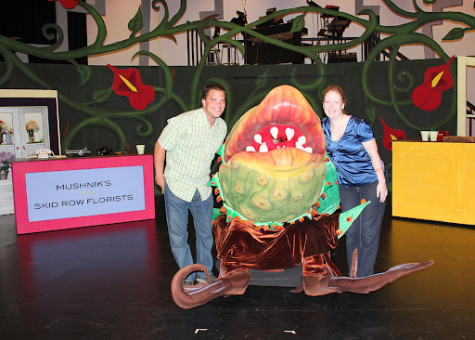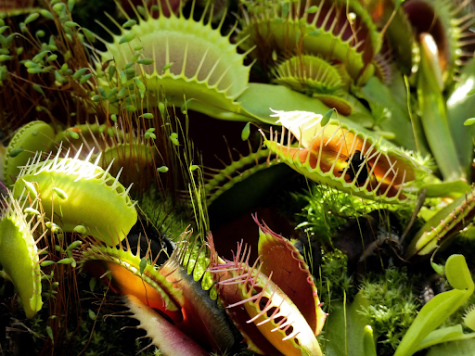Mysteries, Oddities, and Everything Strange: Ya-Te-Veo
June 7, 2022
Ya-Te-Veo: A Suspiciously Hungry Plant
Trees are so cool. Everyone has learned about photosynthesis in science class, where plant life like trees take in the carbon dioxide polluting our atmosphere and use it to create food, emitting oxygen. They create beautiful forests across the globe that are home to billions of creatures and can withstand many natural disasters or other tragic occurrences. They are some of the most quintessential plant life for humans and animals alike, covering nearly 30% of all of Earth’s landmass. Something that everyone can agree on is that these trees don’t move. They stay with their roots buried into the ground, swaying with the wind as it carries out its business. Apparently, some trees don’t fit this mold. The Ya-Te-Veo, for instance, has a mouth.
This legend is pretty much known as being a tree that eats people. The first introduction of this man-eating tree is from the lonely island of Madagascar, off the coast of Africa. A man named Edmund Spencer was authoring a piece for the New York World, a now defunct New York newspaper. On April 26, 1874, Spencer published the first edition of his article in the daily paper, later having it appear in the collective paper of the week. The article included the words of Karl Liche (or Leche), an explorer from Germany. In the letter, Liche describes an encounter with the tree, where he witnessed a local tribe known as the Mkodo tribe perform a sacrifice.
tree is from the lonely island of Madagascar, off the coast of Africa. A man named Edmund Spencer was authoring a piece for the New York World, a now defunct New York newspaper. On April 26, 1874, Spencer published the first edition of his article in the daily paper, later having it appear in the collective paper of the week. The article included the words of Karl Liche (or Leche), an explorer from Germany. In the letter, Liche describes an encounter with the tree, where he witnessed a local tribe known as the Mkodo tribe perform a sacrifice.
Liche’s account was, unfortunately, written in excessive detail, describing how exactly the tree consumed. It would wrap its branches around its victim with terrifying speed. It would silence any screams that erupted from the victim and then swallow it whole, hastily gulping it down. The story was a massive hit when it was introduced, and a newspaper by the name of the South Australian Register published the story in its own papers, only spreading the legend around. An author by the name of Chase Osborn also bore witness to the story and from there wrote a book titled Madagascar: Land of the Man-eating Tree. Osborn had a lot of influence, as he was a politician and served as the governor of Michigan for a period of time. He confirmed its existence and noted that missionaries who traveled to the island were also aware of it, using the same details as Liche’s story.
 This story was one of the most notorious accounts of the Ya-Te-Veo (meaning now I see you in Spanish) until 1955, when a German-American author named Willy Ley claimed that Spencer’s story was completely fake. He said the tribe was a fabricated name, the explorer was a nonexistent person, and the man-eating tree was nothing more than a beast from Spencer’s imagination. Salamanders and other Wonders, Ley’s book, laid out all these claims to the public.
This story was one of the most notorious accounts of the Ya-Te-Veo (meaning now I see you in Spanish) until 1955, when a German-American author named Willy Ley claimed that Spencer’s story was completely fake. He said the tribe was a fabricated name, the explorer was a nonexistent person, and the man-eating tree was nothing more than a beast from Spencer’s imagination. Salamanders and other Wonders, Ley’s book, laid out all these claims to the public.
Although the plant might not exist on Madagascar, there are still accounts of similar creatures all across the world. In Central America, James W. Buel encountered a plant that made a striking hissing sound and spines that would shift around as animals drew near. In Sea and Land, published in 1889, Buel wrote down his account, but he provided no evidence or pictures of the mysterious plant.
A final possibility of the man-eating tree isn’t even a tree, but a plant. A British newspaper editor named William Thomas Stead published a story about an anonymous person’s encounter in Nicaragua. In the London magazine Lucifer, a segment described what was known as “the devil’s snare” by local people. Review of Reviews, the paper that Stead edited for, distributed the story in October 1891. Stead described a plant that could draw blood from people that it made contact with through the point of view of naturalist Mr. Dunstan. He claims that Dunstan found this plant in a swamp with an animal in its grasp. He helped it escape, noting the plant’s ability to tear away flesh and its rope-like vines. Eventually, Stead was exposed as having fabricated the whole story, with no such article of Lucifer detailing the plant and no well-known naturalist going by the name of Mr. Dunstan.
So pretty much every story of the Ya-Te-Veo, whether a plant, vine, or tree, was fake in some way. Although it might be based in real legend, the accounts of various encounters with it have no basis in reality. Despite this, there is still a large existing industry in pop culture of man-eating plants. The well-known movie-turned-musical Little Shop of Horrors featured a plant that consumed people as its main conflict, and the book Life of Pi featured an anecdote about a tree that liked the taste of meat. Regardless, there are little to no plants that do enjoy the taste of flesh, as most don’t have mouths, but it still goes to show the danger of certain species of plants out in the wilderness. For all we know, the tree in your front yard could be hiding a dark secret..
Resources:
https://en.wikipedia.org/wiki/Man-eating_tree














































